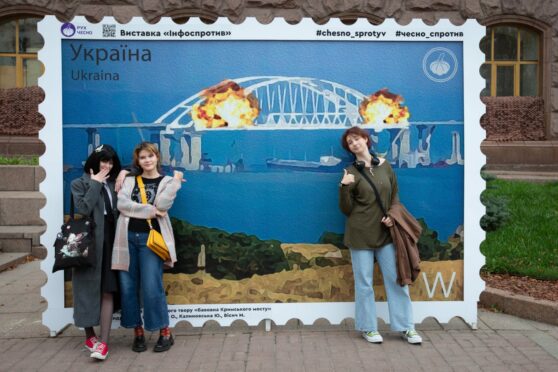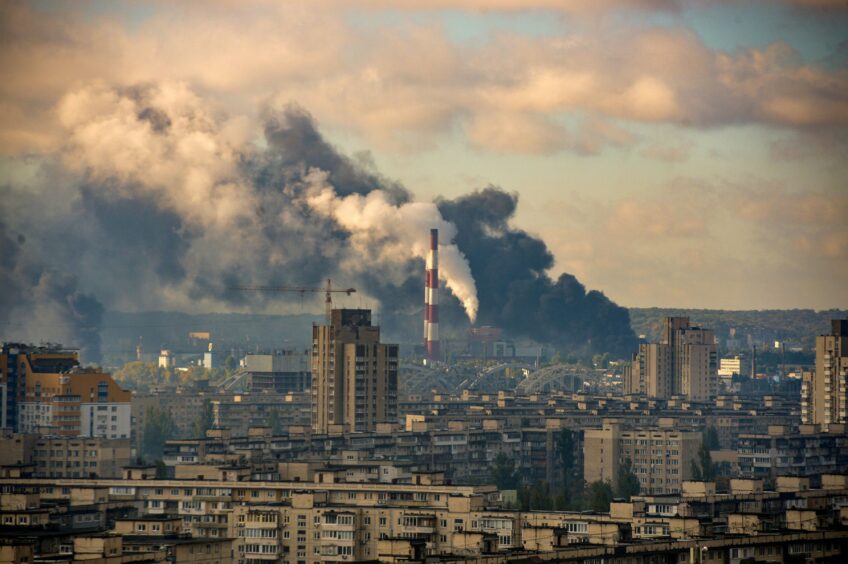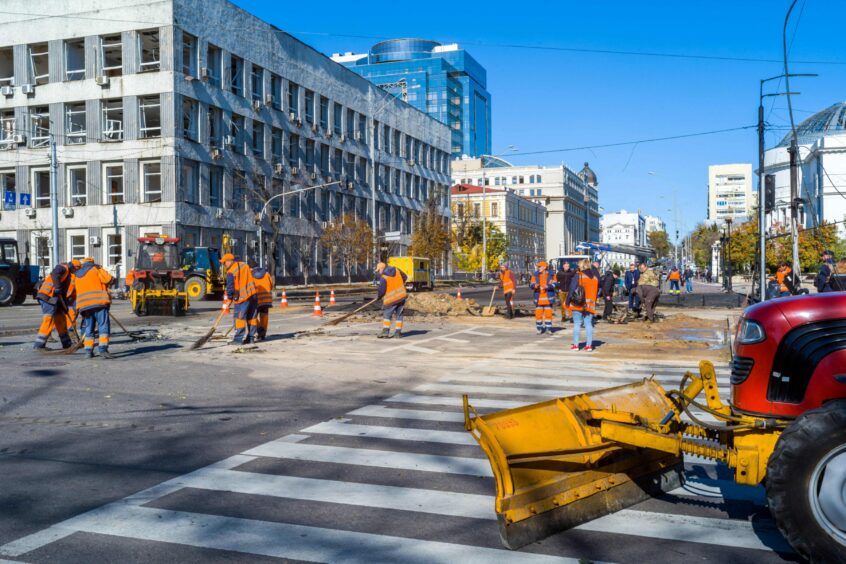
Above the big junction overhead wires dangle, spooling on to the asphalt while soldiers, police and emergency workers cluster around a gaping crater in the road.
Buildings all around are shattered, the window frames hanging askew. The view, like the crunch of broken glass underfoot, is familiar. I just hadn’t expected to see it in downtown Kyiv.
This boulevard – named after Ukraine’s national poet Taras Shevchenko – is one of the main arteries leading out of town. When a missile hit here on Monday, the junction was busy. Of course it was, it was the rush hour. Nearby, another missile would strike a children’s playground. A twisted piece of metal – possibly from the rocket itself – had been placed on the low brick wall. Across the road the grand facades – museums, apartments – were damaged but still standing. Where the rocket hit the tall trees were blackened with fire or smashed into pieces.
Among the dead were a policeman going to work and a doctor leaving her night shift. Her body was so badly burnt, I was told, she could only be identified only by her car model.
This is what Vladimir Putin called “high-precision strikes” on strategic targets – retaliation for the mysterious fire which damaged the Russian bridge to occupied Crimea. Nobody has claimed responsibility for the fire but Putin blames Ukraine – and the strikes were his revenge.
I’d seen scenes like this in Mykolaiv and in Kharkiv. Both those cities have been pounded not just with rockets but with cluster bombs and artillery but Kyiv felt safer. Out of artillery range since the Russians were pushed back in the earlier months of invasion. No missile attacks for months. Never before in this war had the city centre been struck like this.
Normal life, or something approaching it, had long since returned to the capital. When the strikes came I was on the road, driving the 300-mile route from Lviv in the west. No sirens in the countryside; the only indication of the coordinated barrage of missiles hitting every major city were the suddenly shuttered petrol stations and the alerts lighting up our phones.
It was with a strange mix of emotions that I watched the city come into view, tall towers looming, this beautiful, big, bustling place I’d missed so much. The situation felt tense, unpredictable. Rumours of further attacks, of drones in the sky, were filtering through, and the streets were quiet – but not empty. And though the shock was visible on every face, there was no panic in Kyiv on Monday.
It was only a few hours since the junction on Taras Shevchenko boulevard was the site of twisted, burnt cars and bodies, black smoke and fire. But by the time I got there, the clean-up was already under way.
City workers in bright orange hi-viz and hard hats were everywhere – one in a cherry picker hovered over the junction, carefully snipping at the tangled wires. A truck backed up to take rubble from the crater. The place was a hive of activity. In the little park a woman in a patterned headscarf and municipal jacket was using a rake to clear not just autumn leaves but bits of shrapnel from her flowerbed.
The frame of a child’s swing had landed in the middle of it and the plants were flattened by the shockwave but she was undeterred. Nearby two men used an angle-grinder to wrench apart pieces of a bench which the blast had damaged; across the road, from the blown-out windows of an art museum, a hand emerged, brushing the glass off the windowsill with a besom broom.
Roman, a 48-year-old, was gazing up at the battered facade of a grand, eight-floor neoclassical building. He pointed to the window of his friend’s flat: shards of glass, a curtain flapping in the cold breeze. The friend had only just returned to Ukraine with his wife and child – coming back to what seemed like relative safety. They were at home when the rocket landed but escaped unharmed.
“It’s crazy,” said Roman. “These are all apartments, it’s a very beautiful place to live. Because the blasts came during peak hours, I think they were aiming at the infrastructure and the people, two of the most vulnerable things that we have.”
He lived just five minutes’ walk away. “This was the alarm clock for me,” he said.
“I didn’t hear the air raid sirens, we just woke up because the walls were shaking. That’s how the day started, and we’ve been in the bomb shelter all this time.”
Speculating on Putin’s next move, Roman said he still felt relatively safe: “Kyiv is pretty well-protected with air defence but the problem this morning was they had 83 rockets at the same time.”
He explained that having several ‘waves’ of missiles overwhelmed the air defence system, with the second wave landing before they’d had time to reload.
“You can still be hit with rockets,” he noted, “but this is as indication to our Western partners that we need more defensive systems in order to protect civilians from senseless crimes like these.”
For Daniel Slobodin, the attacks only strengthened his resolve to remain in Ukraine and help in any way he can. The 40-year-old had just returned to the city from California.
“It’s like my adopted home,” he said, looking around at the debris-strewn park. “I love it so much.”
He’d managed to sleep through the morning attack, in his flat half a mile away. “It was very strange – I was dreaming about war. Explosions, screaming. And then I turned on my phone and realised these were real.”
Attacks like this are the “playbook of the Russians,” said Daniel. “They get humiliated, such as with the Kerch bridge, and they just lash out. I’m shocked but not so surprised because this is what they do.”
“Look,” he added, pointing, furious, at the brightly painted climbing frame next to us. “This is a playground! They hate, that’s all they do. They hate Ukrainian people because they won’t capitulate to their demands, because they want to be a free country. They want to be their own country. And I’m with them.”
Just a few hours passed before the threat returned – phones pinging with rumours of another strike, apparently credible, and rocket launches in the Caspian Sea. The streets, already quiet, emptied when the sirens sounded again; people walking quickly to the metro stations. At the turnstiles, police stood ushering people through – no tickets needed – and we filed in, taking the long escalators to the platforms below.
Kyiv’s metro just happens to be the deepest in the world. One station, Arsenalna, is more than 300ft underground and it takes five minutes on escalators to reach it. Since the full-scale invasion of February 24, it has sheltered the city’s residents from Russian attacks but it had been many months since anyone needed to do this.
Kyivans know the script though, turning up with blankets and mats, food and water. All across the city people were burrowing underground – metro stations, basements, car parks – and hunkering down for what they hoped would not be a repeat of the morning.
And thankfully it wasn’t. But later that night came more alerts, all through the night, with reports of strikes in other cities – Zaporizhia, Dnipro, Lviv. The power flickered on and off, planned outages plunging parts of the city into darkness, as authorities tried to manage supply. Russia had targeted thermal heating plants and power stations – trying to push the country into the stone age just as winter approaches.
Despite it all, the mood in Kyiv all week has been defiant – sometimes buoyant. Walking through the winding old streets of Podil one evening, using my headtorch to navigate the blackout, I found cheery crowds of young people, arm in arm, singing and laughing, heading home in time for curfew. And while the huge uncertainty about Putin’s next ‘retaliation’ is hard to live with, the brutality of Monday’s attack has only strengthened resolve here.
One friend was telling me this as we drove through the city, laughing as she described how friends think she’s crazy to stay in Kyiv now. “But I’m not going anywhere!” As she said this, I suddenly realised we were passing through the very junction where so many people died. The huge crater was gone, neatly paved over; the lines overhead were fixed. It had taken just a day.

Enjoy the convenience of having The Sunday Post delivered as a digital ePaper straight to your smartphone, tablet or computer.
Subscribe for only £5.49 a month and enjoy all the benefits of the printed paper as a digital replica.
Subscribe © Ukrinform/Shutterstock
© Ukrinform/Shutterstock